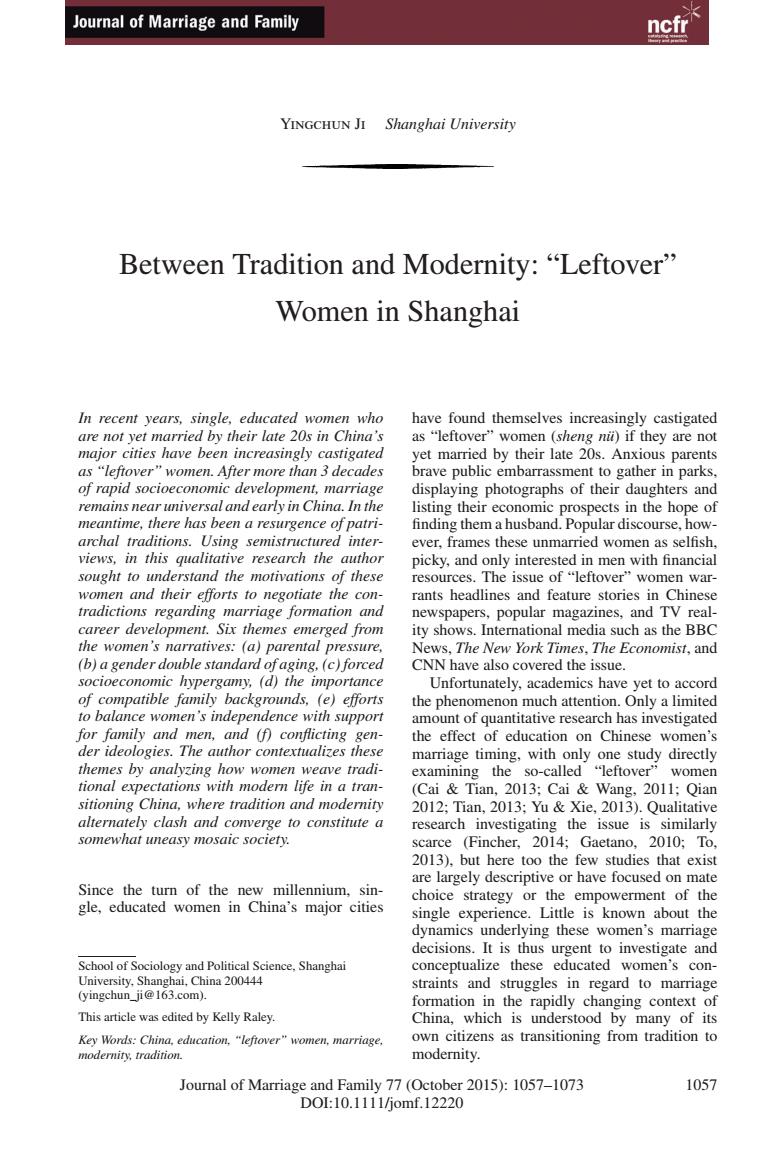正在加载图片...

Journal of Marriage and Family ncfr YINGCHUN JI Shanghai University Between Tradition and Modernity:"Leftover" Women in Shanghai In recent years,single,educated women who have found themselves increasingly castigated are not yet married by their late 20s in China's as "leftover"women (sheng nii)if they are not major cities have been increasingly castigated yet married by their late 20s.Anxious parents as“leftover”women.After more than3 decades brave public embarrassment to gather in parks, of rapid socioeconomic development,marriage displaying photographs of their daughters and remains near universal and early in China.In the listing their economic prospects in the hope of meantime,there has been a resurgence of patri- finding them a husband.Popular discourse,how- archal traditions.Using semistructured inter- ever,frames these unmarried women as selfish. views,in this qualitative research the author picky,and only interested in men with financial sought to understand the motivations of these resources.The issue of "leftover"women war- women and their efforts to negotiate the con- rants headlines and feature stories in Chinese tradictions regarding marriage formation and newspapers,popular magazines,and TV real- career development.Six themes emerged from ity shows.International media such as the BBC the women's narratives:(a)parental pressure, News,The New York Times,The Economist,and (b)a gender double standard ofaging,(c)forced CNN have also covered the issue. socioeconomic hypergamy,(d)the importance Unfortunately,academics have yet to accord of compatible family backgrounds,(e)efforts the phenomenon much attention.Only a limited to balance women's independence with support amount of quantitative research has investigated for family and men,and (f)conflicting gen- the effect of education on Chinese women's der ideologies.The author contextualizes these marriage timing,with only one study directly themes by analyzing how women weave tradi- examining the so-called "leftover"women tional expectations with modern life in a tran- (Cai Tian,2013;Cai Wang,2011;Qian sitioning China,where tradition and modernity 2012;Tian,2013;Yu Xie,2013).Qualitative alternately clash and converge to constitute a research investigating the issue is similarly somewhat uneasy mosaic society. scarce (Fincher,2014;Gaetano,2010;To, 2013),but here too the few studies that exist are largely descriptive or have focused on mate Since the turn of the new millennium,sin- choice strategy or the empowerment of the gle,educated women in China's major cities single experience.Little is known about the dynamics underlying these women's marriage decisions.It is thus urgent to investigate and School of Sociology and Political Science,Shanghai conceptualize these educated women's con- University.Shanghai,China 200444 straints and struggles in regard to marriage (yingchun_ji@163.com). formation in the rapidly changing context of This article was edited by Kelly Raley. China,which is understood by many of its Key Words:China,education,"leftover"women,marriage. own citizens as transitioning from tradition to modernity,tradition. modernity. Journal of Marriage and Family 77 (October 2015):1057-1073 1057 D0L:10.1111jomf.12220Yingchun Ji Shanghai University Between Tradition and Modernity: “Leftover” Women in Shanghai In recent years, single, educated women who are not yet married by their late 20s in China’s major cities have been increasingly castigated as “leftover” women. After more than 3 decades of rapid socioeconomic development, marriage remains near universal and early in China. In the meantime, there has been a resurgence of patriarchal traditions. Using semistructured interviews, in this qualitative research the author sought to understand the motivations of these women and their efforts to negotiate the contradictions regarding marriage formation and career development. Six themes emerged from the women’s narratives: (a) parental pressure, (b) a gender double standard of aging, (c) forced socioeconomic hypergamy, (d) the importance of compatible family backgrounds, (e) efforts to balance women’s independence with support for family and men, and (f) conflicting gender ideologies. The author contextualizes these themes by analyzing how women weave traditional expectations with modern life in a transitioning China, where tradition and modernity alternately clash and converge to constitute a somewhat uneasy mosaic society. Since the turn of the new millennium, single, educated women in China’s major cities School of Sociology and Political Science, Shanghai University, Shanghai, China 200444 (yingchun_ji@163.com). This article was edited by Kelly Raley. Key Words: China, education, “leftover” women, marriage, modernity, tradition. have found themselves increasingly castigated as “leftover” women (sheng nü) if they are not yet married by their late 20s. Anxious parents brave public embarrassment to gather in parks, displaying photographs of their daughters and listing their economic prospects in the hope of finding them a husband. Popular discourse, however, frames these unmarried women as selfish, picky, and only interested in men with financial resources. The issue of “leftover” women warrants headlines and feature stories in Chinese newspapers, popular magazines, and TV reality shows. International media such as the BBC News, The New York Times, The Economist, and CNN have also covered the issue. Unfortunately, academics have yet to accord the phenomenon much attention. Only a limited amount of quantitative research has investigated the effect of education on Chinese women’s marriage timing, with only one study directly examining the so-called “leftover” women (Cai & Tian, 2013; Cai & Wang, 2011; Qian 2012; Tian, 2013; Yu & Xie, 2013). Qualitative research investigating the issue is similarly scarce (Fincher, 2014; Gaetano, 2010; To, 2013), but here too the few studies that exist are largely descriptive or have focused on mate choice strategy or the empowerment of the single experience. Little is known about the dynamics underlying these women’s marriage decisions. It is thus urgent to investigate and conceptualize these educated women’s constraints and struggles in regard to marriage formation in the rapidly changing context of China, which is understood by many of its own citizens as transitioning from tradition to modernity. Journal of Marriage and Family 77 (October 2015): 1057–1073 1057 DOI:10.1111/jomf.12220